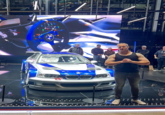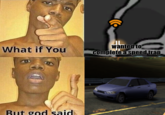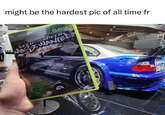Need for Speed
Confirmed 13,584
Part of a series on Electronic Arts (EA). [View Related Entries]
Need for Speed
Part of a series on Electronic Arts (EA). [View Related Entries]
[View Related Sub-entries]
| Navigation |
| About • History • Reception • Online Presence • Related Memes • Search Interest • External References • Recent Images • Recent Videos |
About
Need for Speed (NFS) is a racing video game series published by Electronic Arts known for its high speed police chases, car customization and exotic track locations. In the racing game genre, the franchise is the most commercially successful of all time, having sold over 150 million copies within 10 years of launch.
Gameplay
In the series, players pilot various sports and super cars in a variety of tracks located in urban and exotic locations. containing a myriad of features and mechanics in regards to physics, damage, police pursuits, tuning and modification.
History
Early Series
Note: Entries in the series developed between 1994-2002.
On August 31st, 1994, the first installment in the series The Need for Speed was released for the 3DO console and was subsequently ported to the MS DOS, PlayStation and Sega Saturn systems (shown below, left). The driving experience in the game was unique for simulating real world physics and car sounds, stemming from a collaboration with Road & Track magazine. The game contained seven tracks and eight licensed cars, along with car commentaries, detailed specs and videos showcasing the model in real life.
On March 31st, 1997, Need for Speed II was released, escalating from modern sports cars to rare supercars and prototype track-oriented machines in exotic locations around the world. (shown below, right).
On March 25th, 1998, Need for Speed III: Hot Pursuit was released for PlayStation and Microsoft Windows systems, which reintegrated police pursuits into the game (shown below, left). In March 1999, Need for Speed: High Stakes was released for PlayStation and Windows, which was the first game in the series to include vehicle damage modelling.
In 2000, Need for Speed: Porsche Unleashed (Porsche 2000 in Europe) was released for the Sony Playstation and Microsoft Windows, with the Windows version having several enhancements over the Playstation's, including enhanced visuals, fully 3D-modeled cockpit views, a new soundtrack and advanced damage modelling.
In October 2002, EA released Need for Speed: Hot Pursuit 2 for the Sony Playstation 2, Microsoft Xbox, Nintendo Gamecube and Microsoft Windows, with the Playstation 2 version serving as the debut title for developer Black Box Studios and is considered the definitive version of the game due to various enhancements over the other versions.
Black Box Era
Note: Entries in the series developed between 2003-2008.
On November 17th, 2003, Need for Speed Underground was released for Playstation 2, Microsoft Xbox, Nintendo GameCube and Windows, shifting the focus from exotic sports cars and police pursuits to neon-lit urban street racing. Featuring a story-driven career mode, car customization with aftermarket visual and performance modifications, drag-race and drifting events.
On November 9, 2004, Need for Speed Underground 2 was released for Sony Playstation 2, Microsoft Xbox, Nintendo GameCube and Microsoft Windows systems, which expands car customization and introduces performance dyno tuning, new race types, and open world free roaming for the first time in the series.
On November 11th, 2005, Need For Speed: Most Wanted was released on the Sony Playstation 2, Microsoft Xbox, Nintendo GameCube, and as a launch title for the Microsoft Xbox 360. In addition to retaining Underground's customization, the game reintroduces supercars to the roster and features a new police pursuit system that escalates based on the player's "Heat" threat level.
The Player's silver and blue striped BMW M3 GTR, the "hero" car featured in the game has become iconic to the franchise and in the racing game community, as the vehicle and it's signature livery has been reproduced in various forms in future installments, alongside player made replicas cropping up in other games, such as the Forza Motorsport series.
Need for Speed: Carbon, released in October 2006, serves as a direct sequel to Most Wanted, with the plot continuing immediately after the previous game's events. The career mode focuses on crew-based racing with territory conquest, and adds two new event types: Race Wars, a multi-team race mode with up to 20 opponents, and Canyon Duel, a touge-style 1-on-1 race mode on winding canyon roads. The game also introduces the Autosculpt customization feature, allowing players to further modify bodykits, spoilers and wheels.
Need for Speed: ProStreet, released in 2007, move the setting from illegal street racing in city streets to sanctioned track-day events on closed roads and race tracks. The career mode follows Ryan Cooper, a former illegal street racer looking to make a splash in the professional race scene, as he makes his way to challenging and defeating the various "Kings" of the professional racing leagues across four unique race disciplines. Players will build up a garage of vehicles, each with their own unique "blueprint" tuning configuration for a specific race discipline to compete in the game's events. ProStreet expands on the previous game's performance tuning options with the use of the Autosculpt system, alongside a simulation-style physics, damage, and tire smoke model.
Need for Speed: Undercover was released in November 2008, returning to the open-world gameplay found in Most Wanted and Carbon. In the game's career, you play as an undercover cop for the Tri-City Bay Police, performing the jobs and races given by your handler Chase Linh (played by Maggie Q) in order to infiltrate and take down the members of the Tri-City crime syndicate. The game moves from the simulation style of ProStreet to the arcade style "Heroic Driving Engine" allowing players to perform various stunts and maneuvers with ease.
Intermediate Era
Note: Entries in the series developed between 2009 – 2012.
Need for Speed: Shift and Shift 2: Unleashed, released in 2009 and 2011 respectively, serves as spin-off entries to the series developed by sim racing developer Slightly Mad Studios, creators of Project CARS, boasting a robust simulation-style driving model and a visceral cockpit perspective which reacts to rapid changes in G forces as well as collisions, resulting in camera distortion and instability.
Need for Speed: Nitro was released in 2009 for the Nintendo Wii and later Nintendo DS, replacing the photorealistic visuals of previous games for a disproportionate and stylized cartoon aesthetic which permeates throughout the game's race environments.
Need for Speed: Hot Pursuit, released in November 2010, is the first game in the series to be developed by Criterion Games, developers of the Burnout series. The game setting is inspired from earlier entries of the series, focusing on exotic sports and supercars, scenic environments, and high intensity police pursuits. This game introduces Autolog, the system that allows players to compare career event times, send each other messages, share screenshots among their friends, and discover new players through recommendations.
Need for Speed: The Run was released in 2011, and is the last game in the series to be developed by Black Box.
The game's career follows Jack Rourke, a street racer and marked man on the run from The Mob, as he competes in a coast- to-coast street race with a $25 Million pot while avoiding interference by armed thugs and law enforcement.
The Run is the first game in the series to be developed on the Frostbite Engine created by DICE, developers of Battlefield .
Need for Speed: Most Wanted (2012) was Criterion's second entry in the franchise, and a reimagining of Black Box's Most Wanted, integrating elements found in the Burnout series, such as Takedowns, Collectables, and EasyDrive multiplayer.
The game also changes many fundamental elements from previous games, requiring players to obtain vehicles by discovering "Jack Spots" around the game world, and removing multi-milestone requirements for challenging "Blacklist" racers.
Ghost Games Era
Note: Entries in the series developed between 2013 – 2019 by Ghost Games.
Need for Speed: Rivals was released in November 2013, and is Ghost Games debut title in the series. Gameplay shares many similarities to Criterion's Hot Pursuit, including the "Cops vs. Racers" campaign and utilization of "PursuitTech" weapons and equipment. Rivals also introduces the "AllDrive" multiplayer system, allowing for hands-free, seamless drop-in/drop-out multiplayer gameplay.
On November 15th, 2015, Need For Speed was released, serving as a reboot for the series. The game returns the setting back to the modification and modern car culture featured in the Underground titles, promoting five styles of gameplay (Speed, Style, Build, Crew, Outlaw) that ties into the game's theme and story. The player joins a group of aspiring street racers on their journey through Ventura Bay's underground racing scene, in which they encounter the "Legends" of racing and car culture.
The Windows version of the game released on March 15th, 2016, adding several new features into the game such as unlocked framerate, manual transmission, and wheel support.
Need for Speed: Payback released in November 2017, and follows protagonists Tyler, Jess, and Mac as they form a crew to take on the elite racing crews of Fortune Valley in a revenge-fueled mission to win the Outlaw's Rush, the nation's largest street racing event, hosted by The House, the cartel in control of the city's gambling ring, street racing organization, and corrupt law enforcement.
Payback introduces off-road racing and "Live Tuning" to the mainline series. The game also features multiple playable protagonists, six car classes, and the largest game map of the series to date.
Need for Speed: Heat released on November 8, 2019, and is the last title in the series developed by Ghost Games. Heat follows the player as they seek to earn cash and make a name for themselves in the Speedhunters Showdown hosted in Palm City. And with the help of the Rivera siblings, the player forms a crew to compete with the city's underground scene, as well as Palm City's High-Speed Task Force, which seeks to end the city's illegal street racing activities.
Heat is the first game in the series to feature a customizable driver avatar, custom bodykits designed by digital artist Khyzyl Saleem, as well as several new features, such as engine swaps, exhaust note tuning, and online crews.
Need for Speed: Unbound is the latest entry to the series developed by Criterion (with additional support from CodeMasters), releasing on December 2, 2022. Official cover artwork features A$AP Rocky's Custom Mercedes-Benz 190E superimposed on an urban environment highly stylized with comic and graffiti effects.
Unbound is the third entry in the series developed by Criterion, and their first entry to the series in a decade.
Unbound follows the player character exploring Lakeshore City's underground street-racing scene. But after a job gone bad, the player must rebuild their reputation and garage from scratch, competing to earn a chance to enter The Grand, Lakeshore's ultimate street challenge. Unbound's career mode introduces features a race calendar with events scheduled for daytime and night, side-betting with rivals, and a new event type in the form of The Takeover, a Gymkhana-style motorcross event hosted by A$AP Rocky.
Reception
The Need for Speed series is one of the most commercially successful racing games in history. In October 2014, EA announced the franchise sold more than 150 million copies since 1994.
Online Presence
On February 8th, 2006, the Need for Speed YouTube[2] channel was launched, accumulating upwards of 187 million video views and over 600,000 subscribers over the next 10 years. On April 14th, a Need for Speed Wiki was made on Wikia.[7] In March 2009, the @needforspeed[4] Twitter feed was created, garnering more than 374,000 followers within seven years. In September 2010, a Facebook[5] page titled "Need for Speed" was launched, which gained over 17 million likes in six years. On December 29th, the /r/needforspeed[6] subreddit was created for discussions about the video game franchise. On Twitch,[1] a directory page contains links to feeds of Need for Speed streams.
Related Memes
#CraigItUp
#CraigItUp is a hashtag used to mock the creative director of Criterion Games Craig Sullivan’s design of the Need for Speed games. Commentary typically employs the use of 420 MLG Montages, glitch & bug videos, image macros and general negativity towards the games.
Sergeant Cross' "Everyone!"
"Everyone!" refers to the final cutscene in Need for Speed: Most Wanted(2005), and it's shout-out to the famous line from 1994 movie The Professional by the game's antagonist Sergeant Cross. Serves as a source of humor with long time fans due to the unexpected yet memorable delivery in the scene.
"I Said Right Now!"
"I Said Right Now!" refers to a line in the reveal trailer of Need for Speed Heat spoken by Officer Shaw, one of the antagonists of the game's story, in which he commands a driver to forfeit their car keys. Serves as a point of humor due to the cheesy and over-the-top delivery.
Search Interest
External References
[1] Twitch – Need for Speed
[2] YouTube – Need for Speed
[3] EA – EA Signs Multi-Year Agreement With X-Games Medalist
[4] Twitter – needforspeed
[5] Facebook – Need for Speed
[6] Reddit – /r/needforspeed
[7] Wikia – Need for Speed
Recent Videos 13 total
Recent Images 18 total
Share Pin










![Need For Speed Payback - Defeating The Drift King Aki Kimura's 750,000 Score [Hard Difficulty] Need For Speed Payback - Defeating The Drift King Aki Kimura's 750,000 Score [Hard Difficulty]](https://i.ytimg.com/vi/8TyGbVbcGyU/hqdefault.jpg)











Comments ( 33 )
Sorry, but you must activate your account to post a comment.
Please check your email for your activation code.